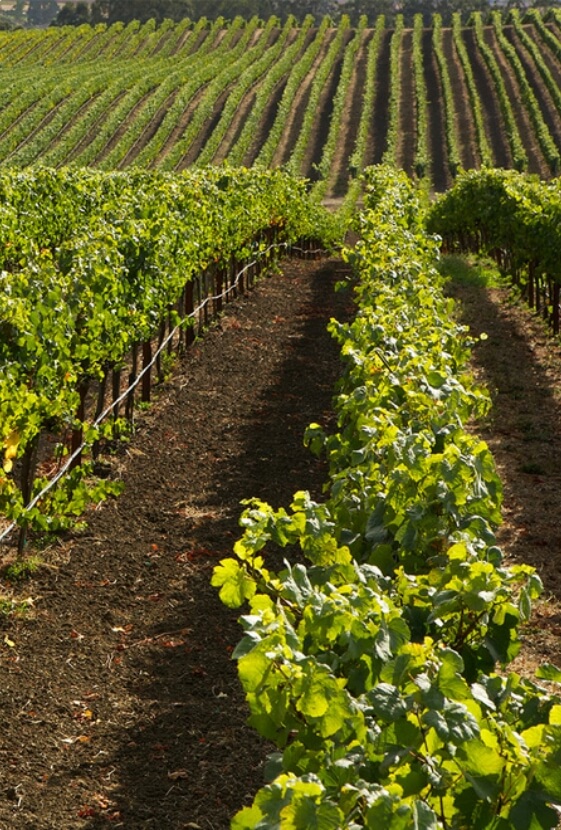The 1-hectare les Perrières vineyard lies just above the Le Clos parcel, halfway up the slope. Les Perrières faces southeast and is somewhat steeper than Le Clos. The vines are an average of 35 years old. The soil is derived from alluvial deposits and consists of deep silt and clay. The top layers, which are moderate in depth, are littered with stones on the surface (calcite and flint) over a meter-thick layer of limestone marl, and the subsoil features streaks of limestone and limestone marl.
Archives: Vineyards
description
Le Clos
The east-facing parcel of vines known as Le Clos is a monopole on .69 hectares of land that runs between the Domaine Ferret property and the village church, abutting the property’s house. Half the vines are about 20 years old and the other half are at least 40. The soil is derived from alluvial deposits and consists of deep silt and clay with a subsoil streaked with limestone and limestone marl.
Stagecoach Vineyard
One of the most famed vineyards of Napa Valley, Stagecoach Vineyard rises 900 to 1,850 feet above the valley’s eastern side. Excavated by Jan and Bart Krupp from a billion tons of rock, the vineyard now has 600 acres of vines in 175 different vineyard blocks. These south-facing slopes with volcanic soil provide fruit to numerous top wineries in the valley. Sequoia Grove has sourced prime Cabernet Sauvignon, Cabernet Franc, Merlot and Petit Verdot from an 18-acre parcel since 2001.
Lamoreaux Vineyard
Located in the Oak Knoll District of Napa Valley, Lamoreaux Vineyard is part of a 750-acre estate acquired by the Lamoreaux family in 1949 and farmed today by Phillip Lamoreaux. There, on 50 acres of primarily volcanic soil, Cabernet Sauvignon and other grapes are grown for some of the finest Napa Valley wineries. Sequoia Grove has sourced prime fruit from a 12-acre parcel since the mid-1980s. In addition to the long-time sourcing of Cabernet Sauvignon Clone 7, the Lamoreaux family in 2007 replanted a portion of the parcel to Clones 169 and 34 specifically for Sequoia Grove.
Morisoli Vineyard
This highly regarded vineyard on the Rutherford bench is managed by Gary Morisoli, who takes great pride in keeping the vines in balance with minimal interaction. In the dry-earth farming style, the heat from the ground helps to concentrate the flavors in the intense black fruit that defines Rutherford Cabernet. Morisoli fruit from a 9-acre parcel has been the foundation of Sequoia Grove’s Cabernet wines since 1982.
Rancho Santa Rosa
A 460-acre property of which 230 acres are planted to vines, Rancho Santa Rosa is located on steep, south-facing hillsides with limestone soils—elements of terroir that are essential to Burgundian-style Pinot Noir and Chardonnay vintners. Pinot Noir grows at the highest reaches of the ranch, with elevations to 1,000 feet. The Chardonnay is established on the rolling hills surrounding the winery. There are also four acres of Syrah planted on the western corridor.
The Rancho Santa Rosa vineyard is subdivided into 59 microblocks that are farmed, harvested and vinified separately, which allows a meticulous level of observation and management of the vineyards, and vinification according to the specific requirements of each small block of fruit. A variety of soil types matched to appropriate rootstocks, and a broad array of clonal selections also give the winemaking team the opportunity to make wines of great diversity and character.
Sonoma County
Sonoma County extends over 60,000 acres of vineyards and includes 15 unique AVAs, including Sonoma Coast, Sonoma Mountain, Sonoma Valley, Alexander Valley, Bennett Valley, Carneros, Chalk Hill, Dry Creek Valley, Green Valley, Knights Valley, Rockpile and Russian River Valley. More than 50 grape varieties are planted in vineyards owned by over 750 growers and 260 wineries. Maritime-influenced conditions make this area notably cooler than Napa, further inland, and a multitude of beneficial soil types make Sonoma County a prime area for high quality wine growing.
Treinta y Dos Vineyard
This was the founding vineyard of Bodega Chacra, acquired in 2004, and consists of a plot of land still supporting vines planted in 1932. These vines produce tiny bunches of small, concentrated berries. Because of the arid climate in the Río Negro Valley, the root louse phylloxera fails to survive here, and the vines can grow on their own rootstocks, a condition believed to produce superior fruit.
Cincuenta y Cinco Vineyard
Purchased in 2006, the 1955 vineyard consists of vines planted in that year. These old vines, growing on their own rootstocks, produce reduced quantities of concentrated fruit.
Le Bruniche Vineyard
The principal white vineyards of the Nozzole estate, Le Bruniche and Casa Vecchia, were once planted in Trebbiano Toscano and Malvasia, which were white grapes included in the Chianti blend before they were phased out of the DOCG rules in 1995. In the mid-1980s viticulturists at Tenuta di Nozzole began experimenting in these vineyards with various classic white vine varieties. Of the two principal white vine vineyards, Le Bruniche was found to be exceptionally well-suited to the Chardonnay variety. Vigneto Le Bruniche lies on one of the estate’s most elevated hillsides, at 900 feet above sea level, on soils consisting of limestone schists and porous marl rubble with an optimum ground thermal temperature and excellent exposure. Extensive experimentation with various clones of Chardonnay preceded selection of the most appropriate vine for the site, which produced its first vintage in 1986.
